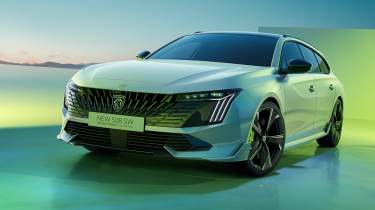Updated 2023 Peugeot 508 PSE revealed
Peugeot’s high performance plug-in hybrid has picked up a selection of updates inside and out
Hot on the heels of its first full year competing in the Le Mans Hypercar class, Peugeot Sport has revealed an updated version of the road-going performance flagship its racer helped inspire, the 508 PSE. UK specifications and pricing are still yet to be confirmed, but with changes both inside and out, Peugeot is hoping it will keep its high performance plug-in hybrid competitive against premium rivals from BMW and Mercedes-AMG.
The 2023 508 PSE’s biggest change is its new exterior design language, borrowing visual elements from both its latest road cars and the 9X8 racer. It’s defined by the new triple-claw daytime running lights, which sit either side of super-slim LED headlights fitted with active Matrix beams. These are integrated into a new, more three-dimensional grille design, crowned by Peugeot’s new badge. This whole section is painted black to reference the LMh racer.
There’s also a new set of rear lights with redesigned internal LED elements, with the Peugeot badge swapped for some new script that sits in the gloss black insert splitting the tail lights. The 20-inch wheels on the flagship PSE model are carried over from before, but there are new colour options and subtle trim and tech changes in the cabin including the more compact switch-style gear selector that replaces the previous joystick.
Powering the PSE is a potent plug-in hybrid powertrain that combines a 197bhp turbocharged 1.6-litre four-cylinder petrol engine with two electric motors – one mounted inside the eight-speed automatic gearbox rated at 109bhp and a second mounted on the rear axle producing 111bhp. Being a complex multi-engine powertrain, power and torque figures aren’t simply cumulative, so are rated at peaks of 355bhp with an accompanying 381lb ft of torque.
The location of these motors have an effect on the PSE’s dynamics too, as the more powerful 111bhp e-motor sits on the rear axle powering the rear wheels, effectively making the PSE all-wheel drive. This helps reduce the 0-62mph time to just 5.2sec. Power for the e-motors is drawn from a 12.4kWh battery (gross), which is rechargeable at speeds of up to 7.4kW, topping up the battery pack in as little as an hour and 40 minutes. With the battery topped up, Peugeot claims it’ll do around 26 miles on electric drive before the petrol motor kicks in.
As before, the PSE’s grunt is underpinned by substantial changes to the chassis hardware, featuring wider tracks (up 24mm at the front and 12mm at the rear), a lower ride height and three-way adjustable dampers. The suspension design itself is relatively straightforward, pairing a MacPherson strut front axle with a multi-link rear. PSE’s wheels are wrapped in Michelin Pilot Sport 4S rubber, and sit in front of large 380mm Alcon front brake discs gripped by four-piston calipers painted in the signature acid green hue.
Standard Peugeot 508 models have also been given the same updates, with a reformed engine range that includes two more plug-in hybrid options made up from the same turbocharged 1.6-litre engine and a single gearbox-mounted e-motor. These come with 178bhp or 222bhp outputs, and exclusively power the front wheels. There’s also two pure combustion options, a 129bhp petrol and 129bhp diesel, but the 215bhp turbocharged four-cylinder will not be offered in Europe or the UK. All 508s utilise the same eight-speed automatic transmission, and aside from the PSE drive the front wheels.
UK prices and final trim specifications have yet to be confirmed, but prices will sit upwards of £55k for the PSE when it goes on sale later in the year.









